The Apple iPad 2 Review
by Brian Klug, Anand Lal Shimpi & Vivek Gowri on March 19, 2011 8:01 PM ESTWiFi and baseband
In our iPad 2 preview I speculated that Apple might have moved entirely to Qualcomm for the iPad 2 baseband, and the most likely guess was to the same Qualcomm MDM6x00 used in the Verizon iPhone. Turns out that I was only partially right. Looking at the difference in weight between the Verizon and AT&T models on the Apple website should've been the dead giveaway, but I initially suspected the reason was more area dedicated to power amps for the GSM/UMTS version.
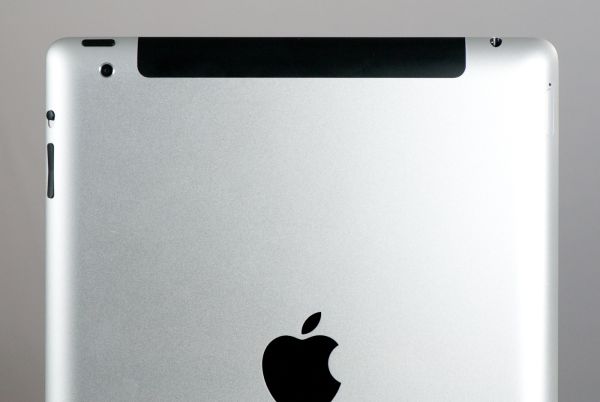
Black RF window at the top, even on a white iPad.
The Verizon iPad 2 shares the same Qualcomm MDM6600 baseband as the Verizon iPhone 4. The AT&T (GSM/UMTS) iPad 2 on the other hand uses the same Infineon, ...errr Intel X-Gold 618 baseband as the GSM/UMTS iPhone 4. It's interesting to see Apple using two different basebands when one could have covered both CDMA2000/EVDO and GSM/UMTS, and faster HSPA at that rate. The X-Gold 618 just isn't super impressive anymore in a world dominated by HSDPA 14.4 and 21.1 compatible basebands. That said, it's a welcome improvement from the X-Gold 608 shared between the iPhone 3G, 3GS and GSM/UMTS iPad, which lacked HSUPA entirely, and thus had a maximum upstream rate of 384 kbps (UMTS speeds).
| GSM/UMTS (AT&T) iPad 2 - Network Support | |||||
| GSM/EDGE Support | 850 / 900 / 1800 / 1900 MHz | ||||
| UMTS/HSDPA/HSUPA Support | 850 / 900 / 1900 / 2100 MHz | ||||
| HSDPA/HSUPA Speeds | 7.2 Mbps / 5.76 Mbps | ||||
| Baseband Hardware | Infineon/Intel X-GOLD 618 | ||||
| CDMA (Verizon) iPad 2 - Network Support | |||||
| CDMA2000-1xEV-DO | 800 / 1900 MHz | ||||
| Theoretical Downstream/Upstream | 3.1 Mbps / 1.8 Mbps | ||||
| Baseband Hardware | Qualcomm MDM6600 | ||||
The cellular enabled versions of the iPad 2 still are easily picked out by the black plastic strip at the top which is an RF window. Curiously, the color of the RF window is black even on the white iPad models, which seems a bit un-Apple. Maybe black made more sense since white plastic might eventually show some discoloration. Through testing the window seems to also be used for WiFi in addition to cellular. The GSM/UMTS version has a microSIM slot and comes with a SIM ejector tool in the package.
I found the microSIM incredibly difficult to eject on my AT&T iPad 2 compared to every other iDevice. You have to insert the ejector tool normal to the curved surface, which ends up being at an angle of nearly 45 degrees with respect to the back surface. It isn't how I expected things to work, and the tray itself is a bit awkward.
I carried around the AT&T version of the iPad 2 and ran over 150 speedtests using Ookla's speedtest.net application. I averaged throughput of 2.76 Mbps down and 802 kbps up, with latency of 390 ms. Anand carried around the Verizon version and saw downstream speeds averaging 872 kbps down, 434 kbps up, and latency of 382 ms.
| 3G Speed Comparison - Speedtest.net to best host | ||||||
| Provider / Data | Verizon - (EVDO) | AT&T - (UMTS/HSPA) | ||||
| Max Downstream | 1.679 Mbps | 6.135 Mbps | ||||
| Average Downstream | 0.872 Mbps | 2.759 Mbps | ||||
| Max Upstream | 0.837 Mbps | 1.635 Mbps | ||||
| Average Upstream | 0.434 Mbps | 0.802 Mbps | ||||
| Average Latency | 382 ms | 390 ms | ||||
| Minimum Latency | 298 ms | 239 ms | ||||
Pricing between the two providers is interesting. It appears that Verizon was careful to not compete with AT&T at the same data package points, instead targeting data packages other than the two 256 MB and 2 GB bundles AT&T already offers. At the same time, pricing at 3 GB on Verizon is exactly where you'd wind up should you run over 2 GB on AT&T and incur the automatic $10.00 overage charge. Interestingly enough, whereas AT&T bills you automatically when you run over your data caps, Verizon simply stops and lets you add more data before the billing cycle ends. It's an interesting distinction, certainly competition is good. In addition, there doesn't appear to be any activation charge for either AT&T or Verizon.
| 3G Enabled USAiPad 2 Data Plan Pricing | ||||||
| Provider | Verizon (CDMA2000/EVDO) | AT&T (GSM/UMTS) | ||||
| 250 MB | NA | $14.99 / mo - $14.99 for each additional 250 MB | ||||
| 1 GB | $20.00 / mo | NA | ||||
| 2 GB | NA | $25.00 / mo -$10 for each additional GB | ||||
| 3 GB | $35.00 / mo | NA | ||||
| 5 GB | $50.00 / mo | NA | ||||
| 10 GB | $80.00 / mo | NA | ||||
So which of the two is the one to get in the US? Ultimately the decision about which is "better" is really a function of local coverage profile, speeds, and how much data you use (which will determine your pricing). If you're an iPad 1 AT&T user and used unlimited, you also have the option of grandfathering it in for some time as well. Unless you’re in an overloaded metropolitan area, AT&T 3G data speeds are undeniably faster. At the same time, Verizon has more EVDO coverage that, while slower, is generally more consistent. Verizon’s pricing also includes heavier data numbers than AT&T does, so if you’re looking for something to completely replace a notebook with and intend to not use WiFi, that’s a fairly big draw.
Speaking of data use, I find the fact that the “Post PC” era includes implicit data caps (neither Verizon nor AT&T offer any unlimited data iPad packages to new customers) somewhat disturbing. I burned through just shy of 1 GB of my 2 GB AT&T plan in 3 days of use. By the time I got finished writing everything on my review sections, I had already used more than half.
Words cannot express my frustration - nay, rage - at the telecom industry's calculated assault on unlimited data plans, first in the mobile space, and now alarmingly with terrestrial DSL. Glass caps on both have always existed (200 or 250 GB for cable, 5 GB for essentially all mobile), but unless you clearly were abusing it, nothing happened. This move to tiered billing is a much more alarming trend. The above screenshot coupled with my use patterns (I have under 37 MB per day for the rest of the month? HA!) is precisely why I can't possibly see myself using the iPad 2 on a day to day basis. I hate watching a meter, but at least I do it. The problem isn't so much the number so much as the psychological effect of knowing you're eventually going to run into the celing.
WiFi
The iPad 2 uses the exact same 802.11a/b/g/n WiFi + Bluetooth 2.1 EDR stack as its predecessor - the BCM4329. Like the iPad 1, the iPad 2 has 65 Mbps (long guard interval, 20 MHz channel, 1 spatial stream) 802.11n support on both 2.4 GHz and 5 GHz. Essentially WiFi speeds and behavior close to the AP is exactly the same as it was before. I’ve seen other WiFi stacks on mobile devices with “802.11n” support provide short guard interval 20 MHz rates of 72 Mbps, but nothing above, yet, so it’s fair to say that the iPad 2 WiFi authentication rate is about par with the competition. That said, Bluetooth 3.0 is already here on a bunch of other devices.
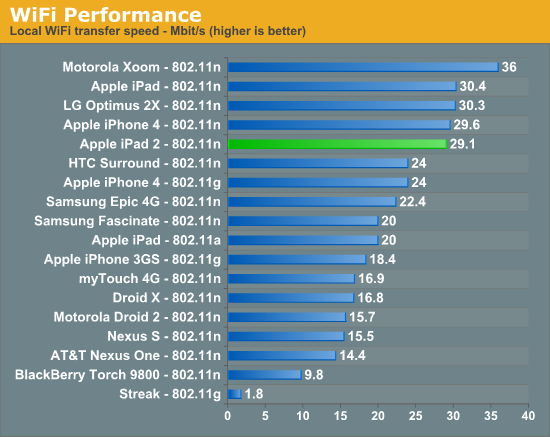
Unfortunately, WiFi range on the iPad 2 is noticeably less than its predecessor, and throughput slows down much earlier on the iPad 2 than it does on the iPad 1. I tested with a WiFi - 3G (AT&T) model and found that I’m able to make it further away from the AP by a good 10 meters or so, but throughput even after you drop one WiFi bar on the iPad 1 is continually better than on the iPad 2.
WiFi throughput also tells a similar story, it just isn’t quite as good as its predecessor. It’s a bit unfortunate since Apple certainly could’ve used this refresh opportunity to be the first to introduce a two spatial stream 802.11n device.
For now, the wrap up with regards to the iPad 2’s WiFi performance is that close to the AP, things are just like they used to be. At the edge of WiFi coverage, the iPad 1 edges out the iPad 2 at maintaining higher negotiated throughput and actual speeds.


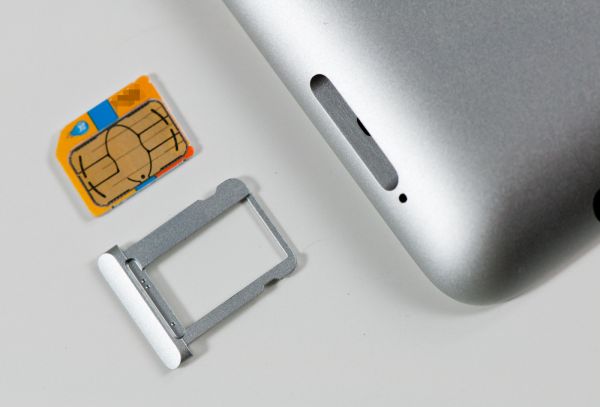
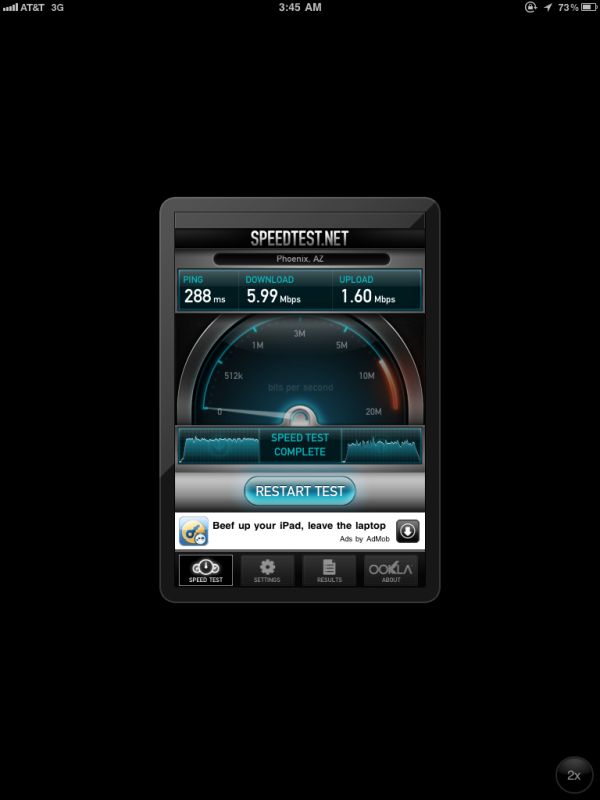
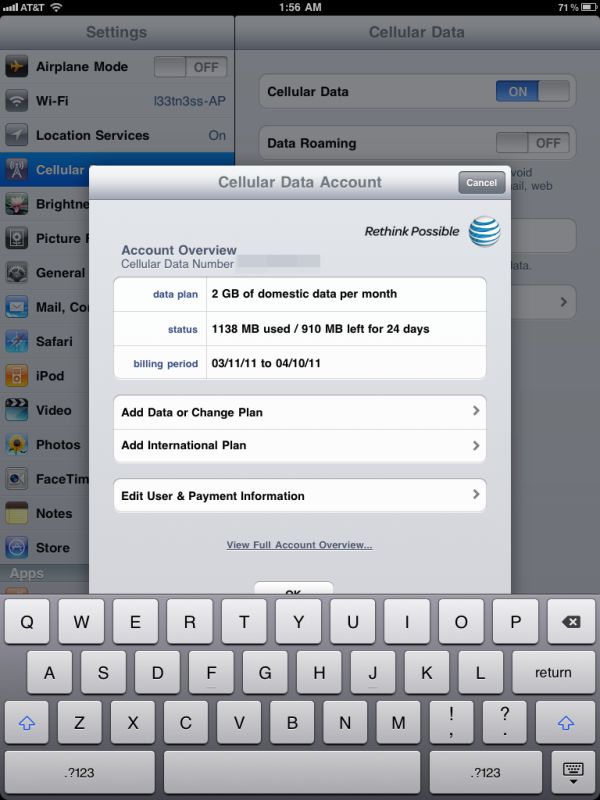








189 Comments
View All Comments
vol7ron - Sunday, March 20, 2011 - link
Smoking the magic of realism, that's the point this device needs to hit. You can take that back to your IPS gods.I didn't say it was feasible to happen right away, but that's where it needs to be for the low-end devices. The upper-end of the spectrum should land in around $450.
BTW, you misunderstand R&D and cost procurement. Just because these devices have a hefty starting price does not mean the cost of materials is even 1/1000 of that price. Whether the service providers are eating the price, or not, it all comes down to the fact that these devices do have a large mark-up. I think you need to consider the cost of an iPod Touch to the iPhone if you need a simpler way to compare - the 3G modem doesn't cost $300 lol and the Touch still had a high mark-up.
"when the competition with a 2 decade head start still hasn’t been able to compete on price" ... no one has had a 2-decade head start. Technology (manufacturing and supply chain) and costs have both shifted over the last 20 years to make things more affordable. You come at this with an emotional response of "that can't happen", when I say it can and it will. Be care about being shortsighted it will come back to bite you one way or another.
name99 - Sunday, March 20, 2011 - link
Look, if you want a crappy cheap computer, go out and buy one. They make $50 computers (none of that extravagant $100 OLPC nonsense) for India powered by 6502s.But at the end of the day you are being disingenuous. You don't ACTUALLY want a $250 PC --- you can get something like that today if you buy a second hand Eee on eBay. What you want is an actual iPad, not something with a tenth of the functionality, but at $250.
Good luck with that.
And spare us this "eventually". If you're not content with a $250 eBay Eee now, buy the time the $250 iPad equivalent comes around, the real iPad 5 will be quadcore, 2GiB of RAM and a retina display screen, and you STILL won't find the cheap equivalent an acceptable choice, not when there's a real device at $600 that is so much better.
medi01 - Monday, March 21, 2011 - link
"Competition" has such devices for as low as about 100$, go google. They don't come with IPS panel or good battery, but how much do those parts cost?Competitors like Samsung do not have any reason to lower prices, as they are competing for different customers anyway. Not to mention, people perceive cheaper devices to be inferior.
medi01 - Monday, March 21, 2011 - link
PSThere are NETBOOKS (from Acer, Lenovo or pretty much anyone) with multi-touch screens for below 300$.
michael2k - Monday, March 21, 2011 - link
They also weigh 2 to 3 times as much and have half or less the battery life.sean.crees - Monday, March 21, 2011 - link
I still am amazed when people complain about the iPad being too expensive. I remember a little over a year ago everyone expected it to have a starting price of $999. It debuted at half that, and people still complain it's too much.It's now a year later, and even Apple's competitors cannot make a device that is competitive with a $499 starting price point or less.
Here is where i see the iPad fitting in. The console and notebook have effectively replaced my PC. Everything i used to do on a PC i now do on either my notebook or my PS3. You're always going to have a cellphone. The tablet then does what you used to use a notebook for 10 years ago.
You end up with a cell phone, a tablet, a notebook and if you want to game, a console.
I don't know if a tablet will ever replace a notebook, maybe for some who can't afford all 3 and have to choose between a tablet and a notebook and don't need the productivity and power you gain with a notebook. Like how a TV is just for media consumption, a tablet is the same but you carry it around with you.
Mishera - Tuesday, March 22, 2011 - link
People complain about the device being too expensive because for what it is capable of doing, and compared to other devices it is overpriced. For Apple the price makes perfect sense for what they portray as a luxury device. It starts with enough room to drop the price (which they did sort of) and to be able to introduce another smaller ipad at some point in the future without cutting into their sails of macs. That's probably why they went with their keyboard choice.I thought about buying one but came to the conclusion that it simply was far to expensive to justify, especially since all I needed was an ereader, and later a new laptop. But I ended up getting on for Christmas so I wasn't complaining. Turns out the iPad is for EXACTLY what Steve said it was for. This is essentially a couch companion. This takes care of all my computer need when I'm at home and don't have to do work. But that's about all it's good for since it's too big to feasible carry around and doesn't replace your laptop.
I still stand by my belief that the ipad is overpriced though much more attractive at $400. I think tablets will be very important in the future, it's just that they are far away and apple right now is only interested in making consumer devices while everyone else follows them. But right now everyone seems happy with just a new toy..
george1924 - Saturday, March 19, 2011 - link
DSC_2328.jpg and DSC_2364.jpggeorge1924 - Saturday, March 19, 2011 - link
Great in-depth review though! Still can't get excited about tablets very much yet. I've had fun playing around with them, but don't think I could justify it along with a laptop, desktop, etc...MonkeyPaw - Saturday, March 19, 2011 - link
Yeah, and the problem with playing with them at the store is that they always look really gross. I was messing with a tablet at a store today, and immediately washed my hands afterwards. I'm not a huge germ-a-phobe, but when I guy blows his nose, then approaches the electronics, I just start getting uneasy. I guess the screen just shows what's on all the mice and keyboards there, too. :p